(QBĐT) - About 20 years ago, the Lunar New Year issue of Quang Binh Newspaper published my poem “Conical Hat” : “White from the inside out/It has always been white/The people who weave conical hats in my hometown/Weave layers of leaves to hide their words inside…”. My hometown is Tho Ngoa village, one of the “Eight Famous Villages” of Quang Binh, a traditional conical hat craft village recognized by the People’s Committee of Quang Binh province.
The hidden story of Tho Ngoa conical hat village
Conical hats appeared around 2,500-3,000 years BC. Images of conical hats were carved on Vietnamese antiques such as Ngoc Lu bronze drum, Dong Son bronze drum... which speaks for itself.
But for researchers, it is still unclear when the conical hat was born in Vietnamese history. The Vietnamese encyclopedia, explaining the word “hat”, stated: “The legend of Saint Giong wearing an iron helmet to fight the An invaders, allows us to believe that hats have existed for a long time in ancient Vietnam…”. From the Ly dynasty onwards, history books have recorded the hat in Vietnamese costumes, mainly folk costumes. By the Nguyen dynasty, the hat had become a popular costume among the people, protecting people and soldiers from the sun and rain.
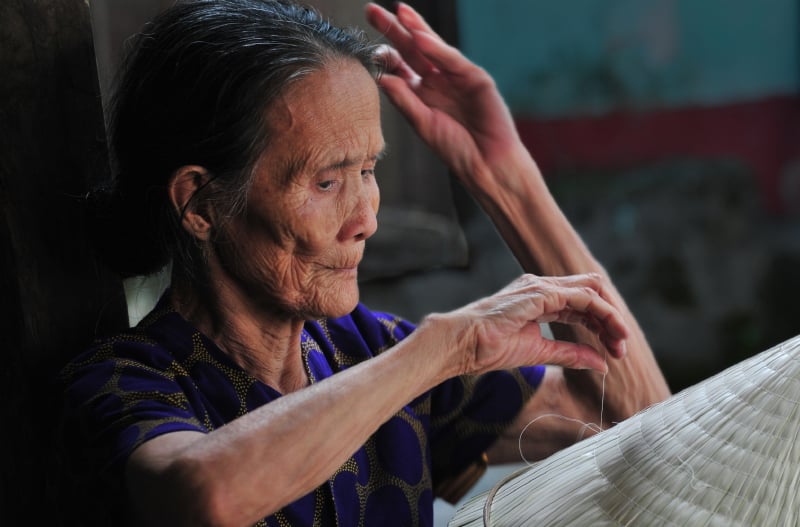 |
A legend in my hometown says: “Once upon a time, there was a year when it rained heavily for weeks, flooding houses and land, making life extremely miserable. Suddenly, a goddess appeared in the rain, wearing a giant hat made from four large leaves sewn together with bamboo sticks. Wherever the goddess went, the dark clouds cleared, the weather became cool. The goddess also taught people many crafts before disappearing. To commemorate the goddess’s merit, people built temples and tried to create a hat by stringing palm leaves together. Since then, the conical hat has become extremely familiar and close to Vietnamese farmers.”
As for when the hat making craft first appeared in Tho Ngoa village, it is only a legend. Therefore, people still argue endlessly. In the genealogies of the long-established families in the village, there is no lineage that mentions the hat making craft.
However, my villagers still agree that the hat making profession appeared in the village in the second half of the 19th century. But there is no agreement on who passed on the hat making profession. The Tran family, a large family in the village, provided the press with information that a person in their family passed on the hat making profession. That Tran family member saw that the Tho Ngoa people had little land and were often flooded with salt water, so they were often hungry and felt heartbroken. He then "crossed the fields and seas" to Hue to learn the profession and then returned to teach the villagers. But the only document that people used to prove this was: "we heard it so".
Unlike the Tran family, Mr. Nguyen T., now 96 years old, affirmed to reporters of a TV station, when I took them to his house to film “The Story of Hats”, that: “The person who brought the hat making profession to the village was a person from Dinh hamlet (now Dinh residential group). However, he was a selfish person. He only sat openly making hats during the day. All the steps of processing raw materials such as hat leaves, brims, and making hat molds were done behind closed doors, secretly at night. A villager saw this and was very angry. Every night, he climbed up to the roof, pulled up the painting to watch. After a while, he learned all the secrets. Thanks to that, the hat making profession flourished throughout the village…” Mr. T. also did not have any documents, only said that my grandfather and my father told him. I think Mr. T.’s story has a higher reliability. Because according to the family tree, Mr. T.’s grandfather was 118 years older than him, so he could clearly understand the story of the hat making profession to tell his children and grandchildren.
Hat makers often gather together to have fun, and the story of passing on the craft is even more fun. The women often smack their lips, saying who passed it on and when did not matter. The important thing is, our village is thanks to the hat making craft, otherwise we would starve to death!
Will it just be... nostalgia?
Most people in my village started making hats when they were 7-8 years old. Due to hunger, we had to make the most of the labor of children and the elderly. We, the skinny children like me, had our faces covered by the hat molds when we made hats. The hat making business had low income, but it utilized the labor of all classes, and we could make, sell, and make a living every day.
I learned how to make hats at a time when hats were only sold to the State. When it was prosperous, the shops paid immediately after buying. But by the end of the 70s of the last century, people were constantly in debt for hats. People were already hungry and even more frustrated. The hat shops were dissolved, thanks to which the private hat trade had the opportunity to develop. The hat making industry in my village was extremely bustling in the 80s.
Every night by the oil lamp, fathers would shave brims, mothers would iron leaves, and children would sew conical hats. The complex sounds would clash together, making a rustling sound. Wealthy families had a transistor radio to listen to music. Some families had a cassette player and a lamp, so many people came to make conical hats.
At that time, we were at the age to flirt with girls. Every night, groups of young men would ride their bicycles to the “Hat Making Clubs” of girls in the village to have fun, play music and sing. Late at night, they would often “settle” at the club where they had a lover. When she finished making a hat, he would stand up and take her home, standing at a corner somewhere to chat. Usually, in the dim light, the white conical hat was the most prominent, sometimes it even served as a shield for passionate kisses.
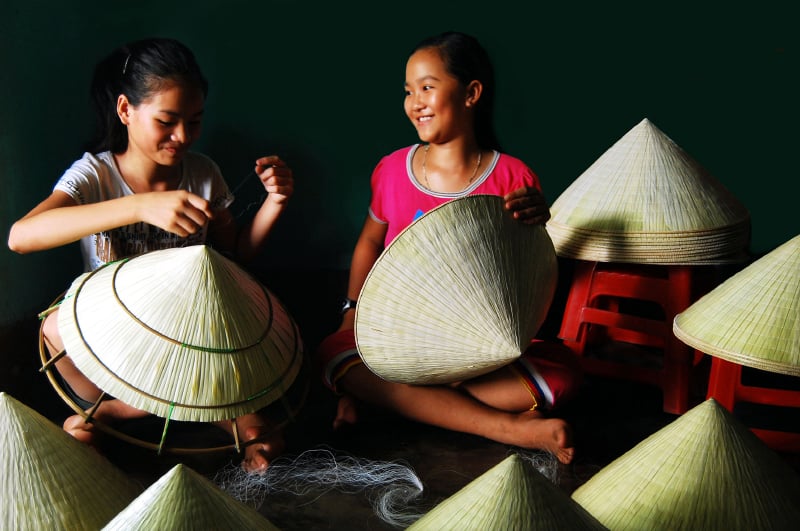 |
The most feared thing for hat makers is the Lao wind, which makes the leaves dry and stiff, making it impossible to iron them. At these times, my mother has to tie bunches of leaves and let them fall near the well water. There were nights when I returned home and saw my mother’s hands stroking and ironing the leaves, which made me shiver, and the verses of poetry came to me: “Dry hands stroke young leaves/Leaves become flowers in mother’s hat, wearing out her youth…” Night after night, every house ironed the leaves, the smell of coal smoke, the smell of ripe leaves and the smell of burnt fabric from the ironing basket permeated my sleep.
In the 90s, Northerners no longer favored hats. Tho Ngoa hats had to move to the South, through traders in Hue. From then on, the way of making leaves by boiling, making brims of Hue penetrated, including coconut leaf hats from the South. The traditional way of making hats of Mai village gradually faded away and then disappeared completely.
In the 21st century, the economy has developed, modern streets are crowded with vehicles, making the hat cumbersome and unsafe when the wind blows strongly. Even cyclists and pedestrians have replaced it with a hat to be more suitable. Mostly, only farmers in the countryside still wear hats to the fields. Hat makers in my hometown have incomes too low compared to the average level, so they give up their hats and go do other jobs. Up to now, the number of hat makers who make a living from their profession is very small. Hat traders have to buy raw hats from other communes in the region, and children and old people in my hometown do the rest.
Fortunately, because of its inherent beauty, the Tho Ngoa conical hat remains forever in poetry, and cannot be absent from the ao dai fashion catwalks. The hat is still an “ornament” that goes with the ao dai for taking photos and filming when Tet comes, spring comes, and for... nostalgia!
Do Thanh Dong
Source: https://www.baoquangbinh.vn/van-hoa/202501/que-toi-lang-cham-non-2224019/


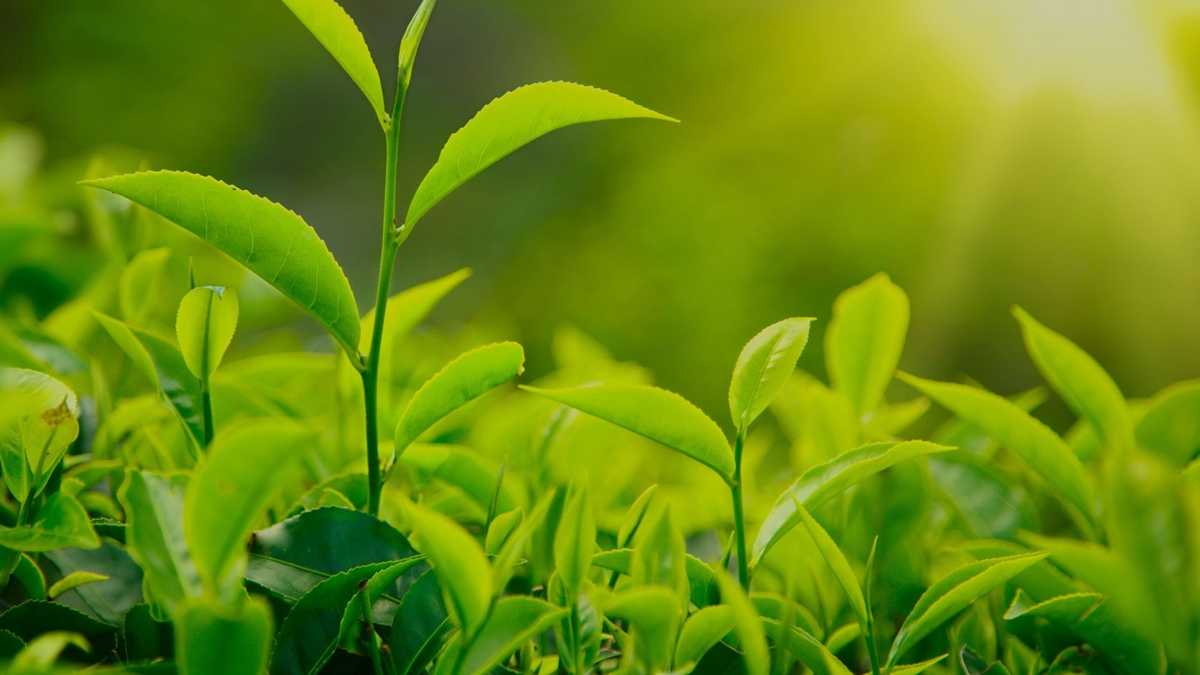


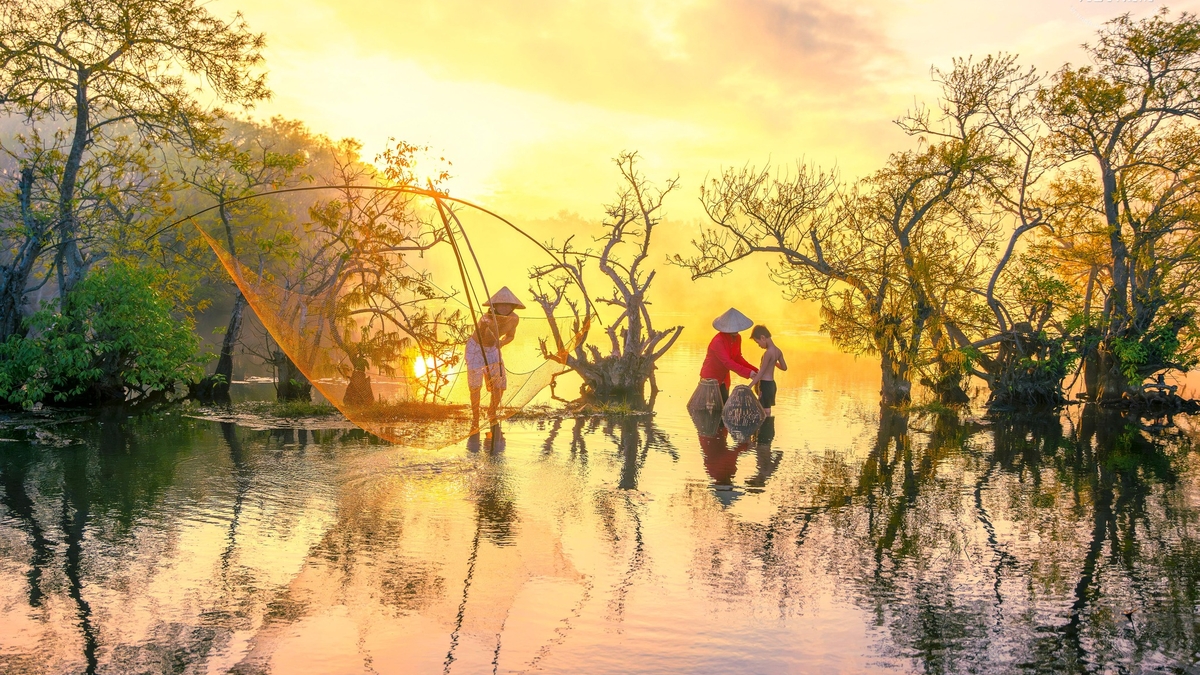


















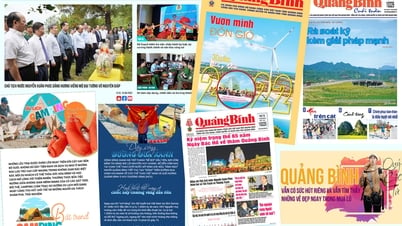









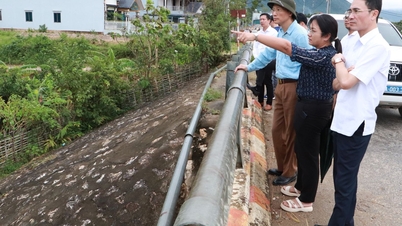


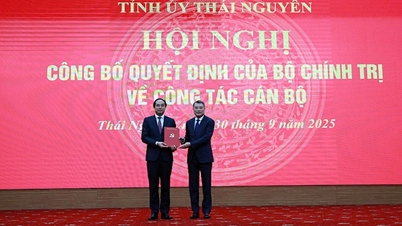
![[Photo] President Luong Cuong receives President of the Cuban National Assembly Esteban Lazo Hernandez](https://vphoto.vietnam.vn/thumb/1200x675/vietnam/resource/IMAGE/2025/9/30/4d38932911c24f6ea1936252bd5427fa)
![[Photo] Panorama of the cable-stayed bridge, the final bottleneck of the Ben Luc-Long Thanh expressway](https://vphoto.vietnam.vn/thumb/1200x675/vietnam/resource/IMAGE/2025/9/30/391fdf21025541d6b2f092e49a17243f)

































































Comment (0)